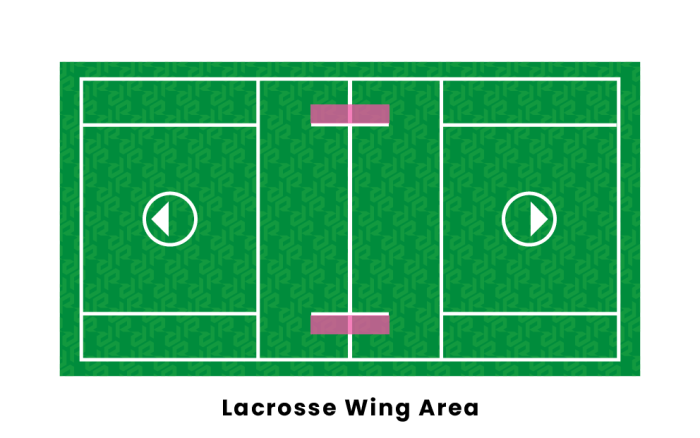Lacrosse out of bounds rules are a crucial aspect of the game, governing the boundaries of play and influencing strategic decision-making. Understanding these rules is essential for players, coaches, and fans alike.
From the sidelines to the endlines and the goal line, lacrosse out of bounds rules create a dynamic and challenging environment. This guide delves into the intricacies of these regulations, providing a comprehensive overview of the consequences, exceptions, and strategies involved in out of bounds play.
General Out of Bounds Rules

In lacrosse, out of bounds refers to situations where the ball or a player leaves the designated playing area.
Common out of bounds scenarios include:
- The ball going over the sideline or end line.
- A player stepping outside the boundary lines.
Consequences of going out of bounds can vary depending on the situation. In general, the team that caused the ball to go out of bounds loses possession. In some cases, penalties may also be assessed, such as a free position shot for the opposing team.
Sideline and Endline Boundaries

The sidelines and endlines are the boundaries that mark the edges of the lacrosse field. When a player goes out of bounds, the game is stopped and a face-off is held.There are a few exceptions to this rule. The “clear” rule allows a player to carry the ball out of bounds and back into play without being stopped.
The “dump-in” rule allows a player to throw the ball out of bounds and then retrieve it without being stopped.The referees are responsible for determining when a player has gone out of bounds. They use a variety of factors to make this determination, including the player’s feet, the ball, and the boundary line.
Crossing the Goal Line

When a player crosses the goal line, the following rules apply:
With the ball:
- If an attacking player crosses the goal line with the ball in their possession, a goal is scored for the attacking team.
- If a defending player crosses the goal line with the ball in their possession, a goal is scored for the attacking team.
Without the ball:
- If an attacking player crosses the goal line without the ball, a goal is not scored.
- If a defending player crosses the goal line without the ball, a goal is not scored.
Types of Goals
There are two types of goals that can be scored in lacrosse:
- Field goal:A field goal is scored when the ball is shot into the goal from outside the crease area.
- Crease goal:A crease goal is scored when the ball is shot into the goal from within the crease area.
The Crease Area
The crease area is a semicircular area in front of the goal that extends from the goal line to the restraining line. The crease area is significant because it is the only area where players can legally hit the ball with their sticks above the shoulders.
If the ball goes out of bounds in lacrosse, it’s a turnover. Speaking of turnovers, have you heard of carne pulpa negra en ingles ? It’s a type of beef that’s popular in Mexico. Anyway, back to lacrosse. If the ball goes out of bounds over the end line, it’s a goal for the other team.
If a player hits the ball with their stick above the shoulders outside the crease area, they will be called for a penalty.
Special Situations

Out of bounds play in lacrosse can occur during face-offs, scrums, and loose balls. These situations present unique challenges, as players are often in close quarters and the ball can quickly change possession.
Face-Offs
When a face-off is whistled, both players must remain behind the restraining line. If a player crosses the line before the whistle, they are called for offsides and the face-off is retaken. If the ball goes out of bounds during a face-off, the face-off is retaken.
Scrums
Scrums occur when two or more players from opposing teams grapple for possession of the ball. If the ball goes out of bounds during a scrum, the team that caused the ball to go out of bounds loses possession.
Loose Balls
Loose balls can occur anywhere on the field. If a loose ball goes out of bounds, the team that last touched the ball before it went out of bounds loses possession.
Out of bounds play can have a significant impact on the outcome of a game. For example, if a team loses possession of the ball due to an out of bounds violation, the opposing team can gain possession and score a goal.
Strategies and Techniques: Lacrosse Out Of Bounds Rules

Effective out of bounds play is crucial in lacrosse, as it prevents turnovers and allows teams to maintain possession of the ball. Here are some strategies and techniques to avoid going out of bounds and recover the ball effectively:
Avoiding Out of Bounds, Lacrosse out of bounds rules
- Proper Footwork:Maintaining good footwork, such as keeping feet shoulder-width apart and facing the direction of play, provides stability and agility to avoid stepping out of bounds.
- Stick Handling:Skilled stick handling allows players to control the ball and keep it within the boundaries while dodging opponents.
Recovering the Ball Out of Bounds
- Back Check:When a player loses possession of the ball out of bounds, a teammate should perform a “back check” by quickly retrieving the ball and passing it back into play.
- Intercept:Players can intercept passes or ground balls that are going out of bounds, gaining possession for their team.
Effective Out of Bounds Play
Effective out of bounds play can significantly contribute to team success. For instance, recovering the ball quickly after an out of bounds situation can lead to a fast break and scoring opportunity. Additionally, preventing opponents from going out of bounds forces them to make risky passes or shots, increasing the chances of turnovers.
Essential Questionnaire
What happens when a player goes out of bounds with the ball?
Possession of the ball is awarded to the opposing team.
Can a player cross the goal line without the ball?
Yes, but they must immediately return to their own half of the field.
What is the “clear” rule?
A player can legally carry the ball out of their defensive zone without being penalized for offsides.